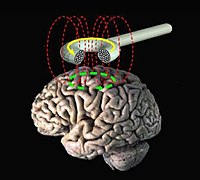
Photo from wikipedia
BACKGROUND The analysis of cortical responses to transcranial magnetic stimulation (TMS) recorded by electroencephalography (EEG) has been successfully applied to study human cortical physiology. However, in addition to the (desired)… Click to show full abstract
BACKGROUND The analysis of cortical responses to transcranial magnetic stimulation (TMS) recorded by electroencephalography (EEG) has been successfully applied to study human cortical physiology. However, in addition to the (desired) activation of cortical neurons and fibers, TMS also causes (undesired) indirect brain responses through auditory and somatosensory stimulation, which may contribute significantly to the overall EEG signal and mask the effects of intervention on direct cortical responses. OBJECTIVES To test differences in EEG responses to real TMS at intensities above and below resting motor threshold (RMT) and a realistic sham stimulation. METHODS 12 healthy subjects participated in one session in which single-pulse TMS was applied to the left motor cortex in 3 different blocks, 150 pulses per block: 110%RMT, 90%RMT and realistic sham stimulation. Cortical responses were collected by a 64 electrode EEG system. TMS evoked potentials (TEPs) and TMS induced oscillations were analyzed. METHODS 12 healthy subjects participated in one session in which single-pulse TMS was applied to the left motor cortex in 3 different blocks, 150 pulses per block: 110%RMT, 90%RMT and realistic sham stimulation. Cortical responses were collected by a 64-channel EEG system. TMS evoked potentials (TEPs) and TMS induced oscillations were analyzed. RESULTS TEPs from all conditions differed significantly, with TEPs from 110%RMT showing overall highest amplitudes and realistic sham lowest amplitudes. Sham stimulation had only minor effects on induced cortical oscillations compared to pre-stimulus baseline, TMS at 90%RMT resulted in a significant increase (50-200 m s) followed by a decrease (200-500 m s) in power of alpha and beta oscillations; TMS at 110% RMT led to an additional increase in beta power at late latencies (650-800 m s). CONCLUSIONS Real TMS of motor cortex results in cortical responses significantly different from realistic sham. These differences very likely reflect to a significant extent direct activation of neurons, rather than sensory evoked activity.
Journal Title: Brain Stimulation
Year Published: 2018
Link to full text (if available)
Share on Social Media: Sign Up to like & get
recommendations!